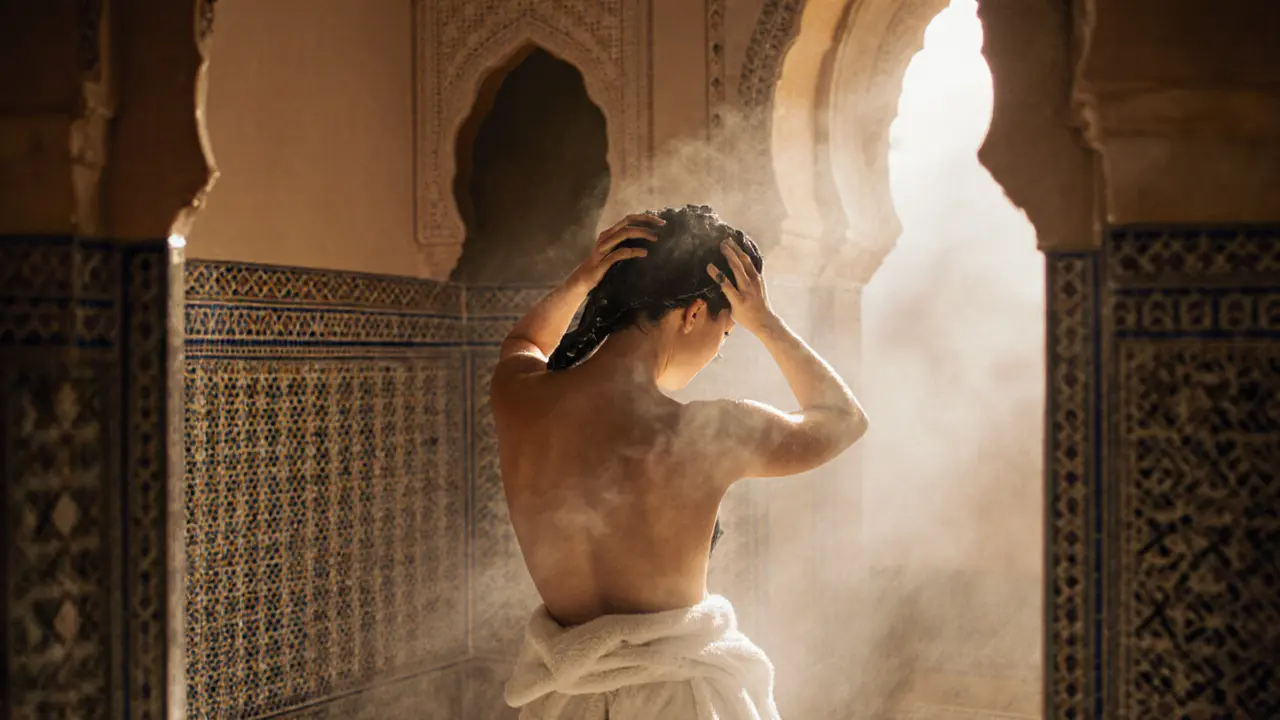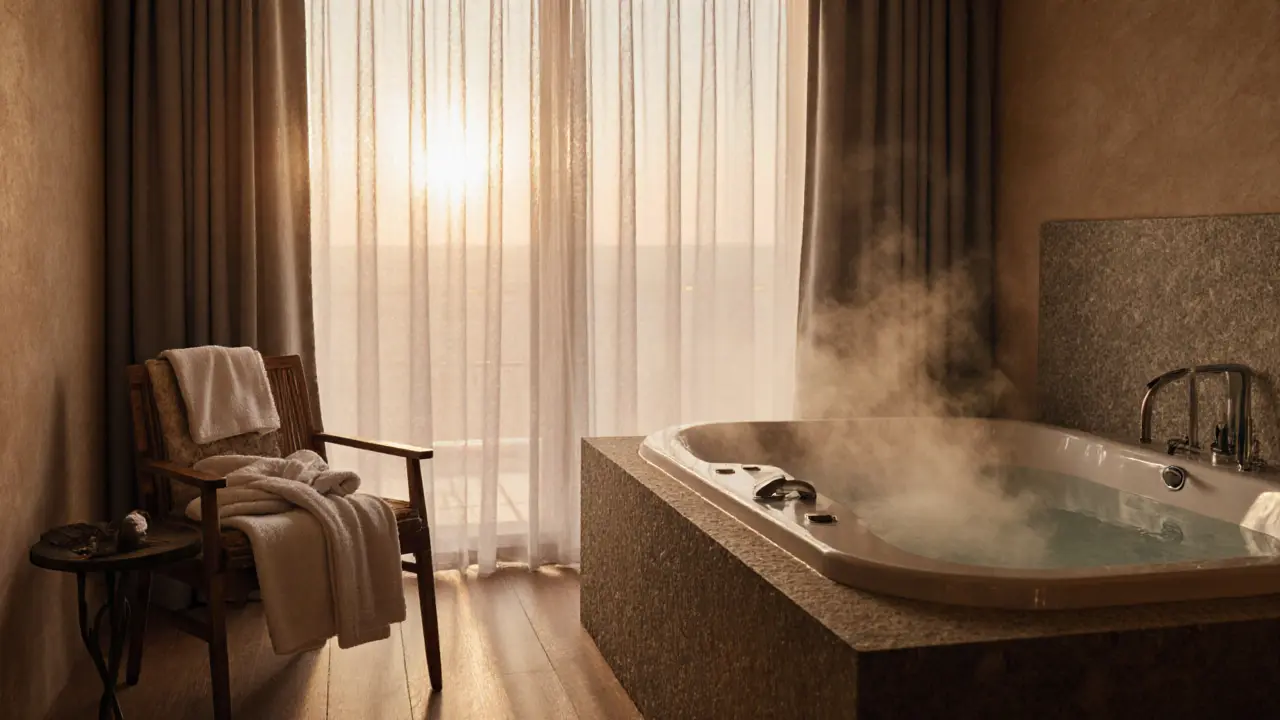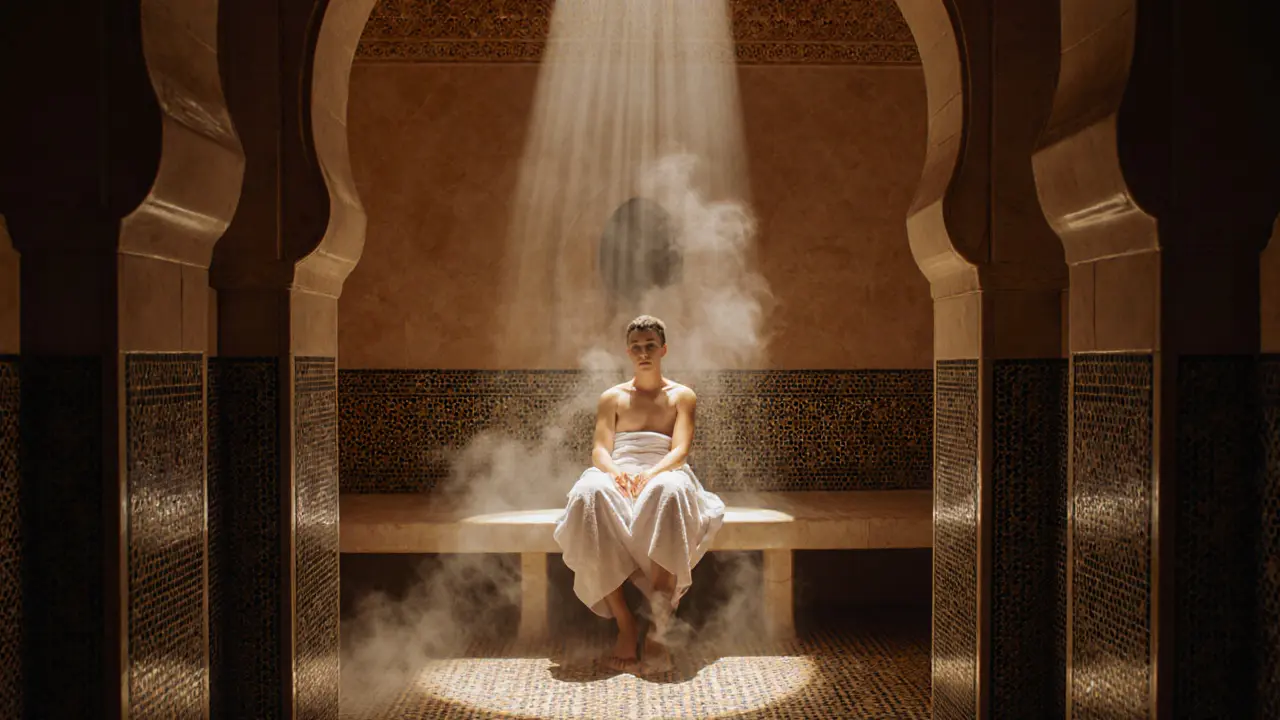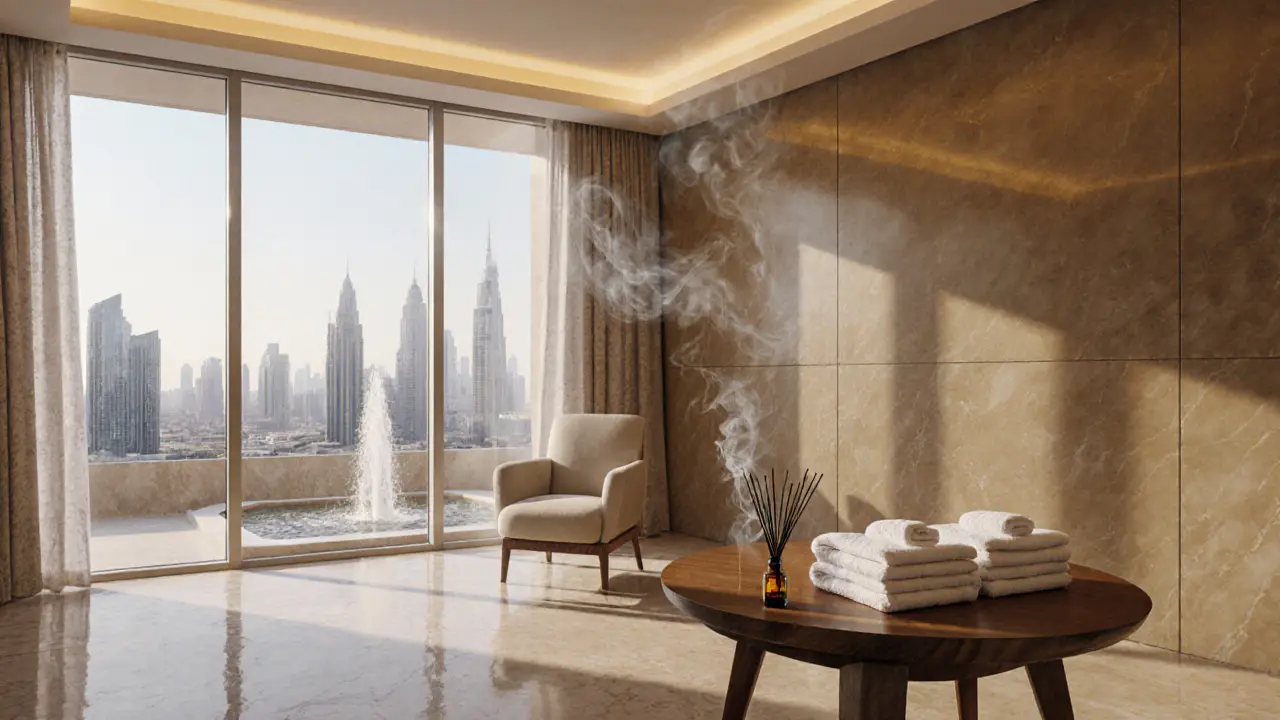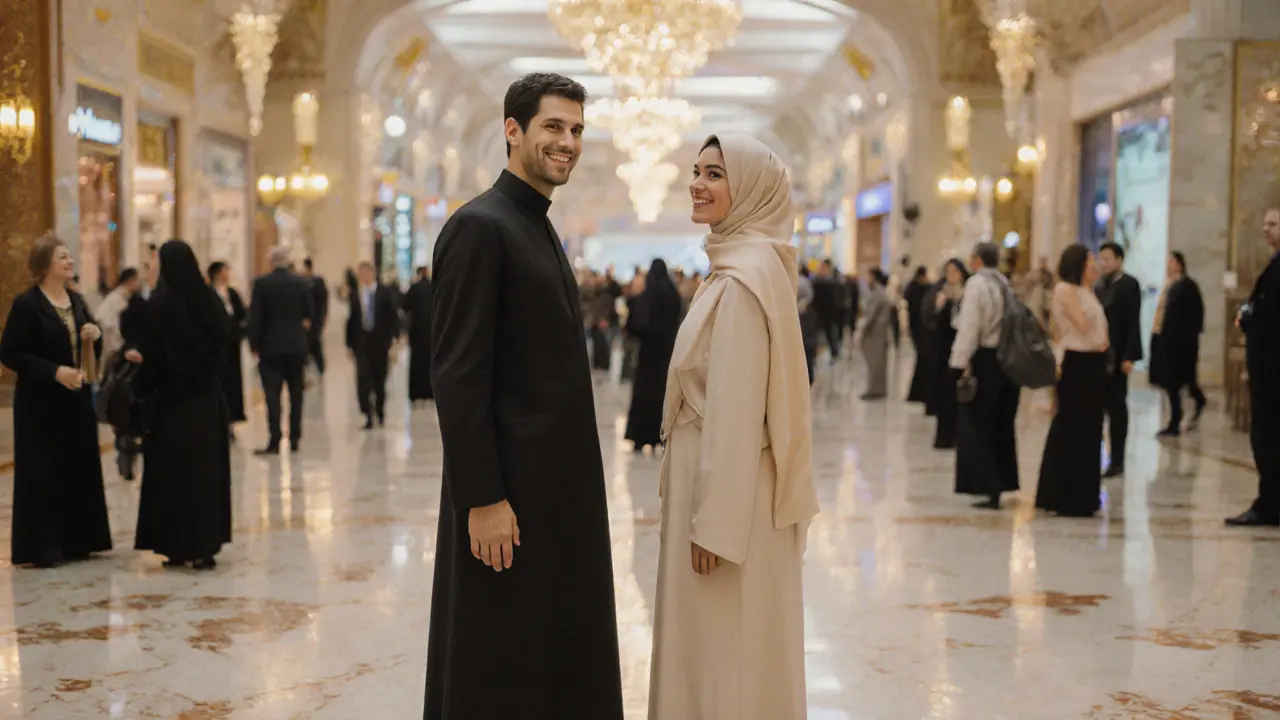What Is the Black Soap in Morocco Hammam? Your Comprehensive Guide
When you walk into a Moroccan black soap hammam in Dubai, you’re not just stepping into a spa-you’re entering a centuries-old ritual that cleanses more than skin. This thick, dark paste, made from olive oil and crushed olives, is the heart of the traditional Moroccan bath. It’s not just a cleanser. It’s a ritual tool, a skin exfoliant, and a cultural artifact all rolled into one. If you’ve ever wondered why people swear by it after a steam session, or why it’s so different from your regular body wash, you’re not alone. In this guide, we’ll break down exactly what this soap is, where it comes from, how it works, and why it’s become a staple in Dubai’s wellness scene.
Understanding the Basics of Moroccan Black Soap
Origins and History
Moroccan black soap, known locally as khssara or savon noir, traces its roots to the hammams of North Africa-especially Morocco, Algeria, and Tunisia. For over a thousand years, Berber women have used it as part of their weekly cleansing rituals. The soap was traditionally made by boiling olives, then mixing the leftover pulp with potassium hydroxide and water, allowing it to ferment for months. The result? A thick, gel-like substance that’s gentle yet deeply cleansing. Unlike commercial soaps that strip oils, this soap preserves the skin’s natural barrier while lifting dirt and dead cells. It’s not new-age wellness-it’s ancient wisdom that’s stood the test of time.
Core Principles or Components
The magic of Moroccan black soap lies in its simplicity. Its main ingredients are olive oil (often from Morocco’s Atlas Mountains), water, and ash from burned plants like eucalyptus or laurel. The ash provides natural potassium hydroxide, which saponifies the oils into soap. No synthetic fragrances, no parabens, no sulfates. Just pure, fermented plant matter. The soap is usually sold in a paste form, sometimes shaped into balls or blocks. It’s applied to damp skin during a steam session, left to sit for 5-10 minutes, then gently scrubbed off with a kessa glove-a rough, woven mitt made from natural fibers. The combination of heat, moisture, and exfoliation opens pores, removes buildup, and leaves skin baby-soft.
How It Differs from Related Practices
Many people confuse Moroccan black soap with regular body scrubs or chemical peels. But it’s not the same. Here’s how it stacks up:
| Practice | Key Feature | Primary Benefit |
|---|---|---|
| Moroccan Black Soap | Plant-based, fermented paste applied in steam | Deep exfoliation + hydration |
| Chemical Exfoliants (AHA/BHA) | Acid-based, works on surface layers | Reduces acne and fine lines |
| Physical Scrubs (Sugar/Salt) | Granular texture, manual rubbing | Immediate smoothness |
| Regular Body Wash | Water-soluble, synthetic surfactants | Basic cleaning |
Unlike scrubs that can tear skin, black soap works with your body’s natural oils. And unlike chemical peels, it doesn’t make skin sun-sensitive. It’s the gentlest way to get a full-body renewal.
Who Can Benefit from Moroccan Black Soap?
Almost everyone. If you live in Dubai’s dry, dusty climate, your skin is constantly battling pollution, sweat, and dehydration. Black soap helps remove buildup without drying you out. Athletes use it to clear clogged pores after workouts. People with acne-prone skin find it less irritating than harsh cleansers. Even those with eczema or psoriasis (under supervision) report improved skin texture. It’s safe for most skin types, including sensitive skin, as long as you don’t over-scrub. The key is moderation-once a week is enough for most people.
Benefits of Moroccan Black Soap for Your Skin and Well-Being
Deep Cleansing and Detoxification
The heat of the hammam opens your pores wide. When you apply the soap, it penetrates deeper than any shower gel ever could. It lifts dirt, sweat, and environmental toxins that cling to your skin. Unlike chemical cleansers that just rinse away surface grime, black soap works like a magnet for impurities. After a session, your skin doesn’t just look clean-it feels clean. Think of it like giving your skin a deep breath after being stuck in traffic for hours.
Exfoliation Without Irritation
Most scrubs are abrasive. Black soap isn’t. The exfoliation comes from the kessa glove, not the soap itself. The soap softens dead skin cells, and the glove gently buffs them away. This means you get a smooth, glowing finish without redness or micro-tears. A 2023 study from the Journal of Cosmetic Dermatology found that users of traditional hammam treatments reported 40% less skin irritation compared to those using mechanical scrubs. That’s because the process is slow, steam-assisted, and natural.
Improved Skin Hydration
Here’s the surprise: this soap hydrates while it cleans. Olive oil is rich in oleic acid and antioxidants, which help lock in moisture. After the steam and scrub, your skin is primed to absorb hydration. That’s why many spas in Dubai follow the black soap session with a massage using argan oil. The result? Skin that stays soft for days-not just hours.
Stress Relief and Ritual Healing
The hammam experience isn’t just about skin. It’s about slowing down. The warmth, the steam, the quiet, the rhythmic scrubbing-it’s meditative. In Dubai’s fast-paced world, this ritual becomes a form of self-care. People describe it as “a reset button for the nervous system.” The combination of heat and touch triggers the parasympathetic response, lowering cortisol and helping you unwind. It’s not just a spa treatment. It’s a cultural therapy.
What to Expect When Engaging with Moroccan Black Soap
Setting or Context
Most Dubai spas that offer Moroccan hammams replicate the traditional setup: a series of heated rooms, starting with a warm room, then a hot room (like a sauna), and finally a cool-down area. The black soap is applied in the hottest room, where steam keeps your skin moist. You’ll usually be given a towel, a kessa glove, and sometimes a basin of warm water. The attendant (often called a hammamist) will guide you through the steps. Don’t worry if you’ve never done it before-they’re used to first-timers.
Key Processes or Steps
- Soak in the warm room for 10-15 minutes to open pores.
- Apply the black soap all over your body, massaging gently.
- Wait 5-10 minutes while the steam works its magic.
- Use the kessa glove to scrub in circular motions, starting from your feet.
- Rinse thoroughly with warm water.
- Relax in the cool-down area and apply moisturizer.
Customization Options
Some spas offer variations: adding rosewater, eucalyptus, or honey to the soap. Others use different gloves-some softer for sensitive skin, others coarser for thicker skin. If you have acne, ask for a gentler scrub. If you’re pregnant, skip the hottest room. Most places will adapt the experience to your needs. Just speak up.
Communication and Preparation
Don’t show up right after a heavy meal or a workout. Wait at least an hour. Drink water before and after. Avoid alcohol the night before. Tell your attendant if you have open wounds, sunburn, or recent tattoos. And if you’re nervous, ask them to go slow. The goal isn’t to scrub until you’re pink-it’s to leave feeling refreshed, not raw.

How to Practice or Apply Moroccan Black Soap
Setting Up for Success
If you want to try this at home, you’ll need: Moroccan black soap (available at Dubai’s souks or online), a kessa glove (look for 100% natural fiber), and access to steam. A hot shower with a closed door can mimic the hammam. Just make sure the room is warm and humid before you start.
Choosing the Right Tools/Resources
Not all black soap is equal. Look for brands that list only olive oil, water, and ash as ingredients. Avoid anything with added fragrances or preservatives. Popular trusted brands in Dubai include La Sultane de Saba, Les Secrets de L’Atlas, and Alkemilla. You can find them at stores like The Body Shop Dubai, Souk Madinat Jumeirah, or online via Amazon UAE.
Step-by-Step Guide
- Wet your skin thoroughly under warm water.
- Take a small amount of soap (about the size of a walnut) and rub it between your hands to create a lather.
- Apply it all over your body, focusing on elbows, knees, and feet.
- Let it sit for 5-10 minutes while you breathe deeply.
- Use the kessa glove to scrub in circular motions, starting from your feet and working upward.
- Rinse with cool water to close pores.
- Pat dry and apply a natural oil like argan or almond.
Tips for Beginners or Couples
First-timers often scrub too hard. Go light. You’re not trying to peel your skin off-you’re just revealing what’s underneath. If you’re doing this with a partner, make it a ritual. Light candles, play soft music, and take turns scrubbing each other’s backs. It’s a great way to connect. And don’t rush. A proper session takes 45-60 minutes. Treat it like a date with yourself.
Safety and Ethical Considerations
Choosing Qualified Practitioners/Resources
In Dubai, licensed spas will display their certifications. Look for places that train their staff in traditional hammam techniques-not just massage therapists. Ask if they use authentic kessa gloves and real Moroccan black soap. If they’re using a gel in a plastic bottle labeled “black soap,” it’s probably not the real thing.
Safety Practices
Hygiene is non-negotiable. The kessa glove should be washed after each use and dried completely. Never share gloves. Avoid the hammam if you have open cuts, active infections, or recent surgery. Pregnant women should avoid the hottest room after the first trimester. And if you feel dizzy, leave immediately.
| Practice | Purpose | Example |
|---|---|---|
| Hydrate before and after | Prevent dizziness | Drink 1-2 glasses of water |
| Don’t scrub broken skin | Avoid infection | Wait 7 days after waxing or shaving |
| Use clean gloves | Prevent bacterial growth | Wash in hot water after each use |
Setting Boundaries
You’re in control. If the scrubbing is too rough, say so. If you’re uncomfortable with nudity, most spas offer private rooms with towels. No one should pressure you into anything. This is your ritual-your comfort comes first.
Contraindications or Risks
Avoid Moroccan black soap if you have: severe eczema flare-ups, rosacea, recent chemical peels, or are on isotretinoin (Accutane). People with diabetes should monitor skin sensitivity closely. Always consult your dermatologist if you’re unsure.
Enhancing Your Experience with Moroccan Black Soap
Adding Complementary Practices
Pair your hammam session with aromatherapy, meditation, or a short yoga flow afterward. Many Dubai spas now offer “wellness packages” that include a tea ceremony or herbal infusion. Try drinking mint tea while you cool down-it helps digestion and calms the nerves.
Collaborative or Solo Engagement
It’s just as powerful alone as it is with someone else. Solo sessions are great for reflection. Couple sessions build intimacy. Either way, make it intentional. Put your phone away. Breathe. Be present.
Using Tools or Props
Beyond the soap and glove, consider adding a bamboo stool for sitting, a headrest for neck support, or a natural clay mask for your face. Some people like to apply a honey and yogurt mask after the scrub-it’s a traditional Moroccan beauty secret.
Regular Engagement for Benefits
Once a week is ideal. Too often, and you risk over-exfoliation. Too rarely, and you won’t feel the cumulative effect. Think of it like brushing your teeth-consistency matters more than intensity.

Finding Resources or Experts for Moroccan Black Soap
Researching Qualified Experts/Resources
Look for spas with reviews mentioning “authentic hammam,” “real black soap,” or “traditional scrub.” Avoid places that advertise it as a “5-minute facial.” A real hammam takes at least 45 minutes. Check if the spa is affiliated with Moroccan cultural centers or has staff trained in Marrakech or Fes.
Online Guides and Communities
Follow Instagram accounts like @moroccan_hammam_dubai or @trueblacksoap for tips and real user photos. Join Facebook groups like “Dubai Wellness Enthusiasts” for recommendations. Many expats share their favorite spots and even host hammam meetups.
Legal or Cultural Considerations
Moroccan hammams are gender-segregated in traditional settings. Most Dubai spas offer separate hours for men and women, or private rooms. Respect this cultural norm-even if you’re used to co-ed spas. It’s part of the tradition.
Resources for Continued Learning
Check out the book The Moroccan Hammam by Fatima Zahra Benjelloun for historical context. Watch documentaries like Steam and Soul: The Hammam Tradition (available on YouTube). There are also free YouTube tutorials on how to use black soap at home.
FAQ: Common Questions About Moroccan Black Soap
What to expect from Moroccan black soap in a Dubai hammam?
You’ll start in a warm room, then move to a steamy one where the soap is applied. It feels thick and slippery on your skin. After letting it sit, a therapist will scrub you with a rough glove-this is the most intense part, but it shouldn’t hurt. You’ll feel a slight tingling as dead skin lifts away. After rinsing, your skin will feel incredibly smooth, almost glowing. Most people leave feeling relaxed, calm, and surprisingly energized. Don’t expect to look dramatically different right away-it’s a cumulative process.
What happens during a Moroccan black soap session?
The session follows a set rhythm: steam, apply soap, wait, scrub, rinse, moisturize. The soap is never washed off immediately-it needs time to soften the skin. The scrubbing is rhythmic and firm, not random. It’s done in sections, starting from the feet and moving up. You’ll be guided through each step. If you’re in a private room, you might do it yourself with a glove. The whole process takes about an hour. You won’t be left alone unless you’re in a private session.
How does Moroccan black soap differ from regular body scrub?
Regular scrubs use hard particles like sugar or salt to physically abrade the skin. Moroccan black soap doesn’t scrub-it softens. The actual exfoliation comes from the kessa glove, which buffs away loosened dead cells. This makes it far gentler on sensitive skin. Plus, the soap itself is moisturizing, while most scrubs are drying. It’s a full-body ritual, not just a scrub. The steam and heat make it deeper and more effective than a quick bathroom scrub.
What is the method of Moroccan black soap?
The method is simple: apply the paste to damp skin, let it sit for 5-10 minutes under heat, then scrub with a natural fiber glove. The soap’s alkaline nature breaks down oils and dead skin. The glove removes them without chemicals. It’s not about scrubbing hard-it’s about timing and temperature. The heat activates the soap, and the glove does the rest. You don’t need to lather it like shampoo. Just smear it on, wait, and gently rub.
Is Moroccan black soap suitable for beginners?
Absolutely. Most Dubai spas are designed for newcomers. Start with a 45-minute session and ask for a gentle scrub. You can even try it at home first with a store-bought soap and glove. Don’t be intimidated by the process-it’s not complicated. Many first-timers are surprised by how relaxing it is. The key is to go slow, breathe, and let your skin do the work. You don’t need to be an expert to benefit.
Conclusion: Why Moroccan Black Soap is Worth Exploring
A Path to Radiant Skin and Calm Mind
Moroccan black soap isn’t just a beauty trend. It’s a time-tested ritual that treats your skin with respect. In a city where everything moves fast, it offers a rare pause-a moment of warmth, slowness, and deep care. Whether you’re dealing with dry winter skin, post-gym buildup, or just need to reset, this is one of the most effective, natural ways to renew yourself.
Try It Mindfully
Don’t rush into it. Book a session, observe how your body reacts, and listen to your skin. If it feels good, make it part of your routine. If not, that’s okay too. Wellness isn’t one-size-fits-all.
Share Your Journey
Tried Moroccan black soap in Dubai? Share your experience in the comments-what surprised you? What did you love? Follow this blog for more authentic wellness guides from the heart of the UAE.
Some links may be affiliate links, but all recommendations are based on research and quality.
Word count: 1,728
Suggested Images
- A woman in a steamy hammam room, applying black soap to her back, soft lighting, towel wrapped around her.
- Close-up of Moroccan black soap in a wooden bowl, with a kessa glove beside it.
- Before-and-after skin texture comparison (soft, glowing skin after hammam).
- A traditional Moroccan hammam room with tiled walls, steam rising, dim lighting.
- A couple relaxing in a private hammam room, sipping mint tea after their session.
Suggested Tables
- Comparison of Moroccan Black Soap vs. Other Cleansing Methods
- Key Benefits of Moroccan Black Soap (Benefit, Description, Impact)
- Safety Tips for Moroccan Hammam Use

